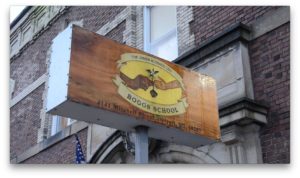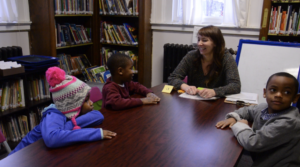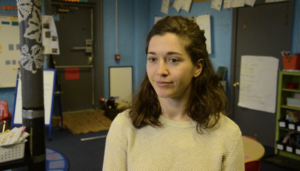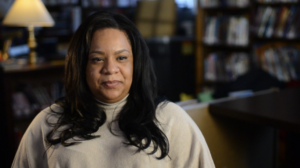
The James and Grace Lee Boggs School.
The Institute for Multi-Sensory Education’s approach is based on the Orton-Gillingham methodology. OG is a long-used, research-based style of reading instruction that was traditionally used to help children with Dyslexia and other learning differences read, with incredible documented success. Twenty-five years ago the founders of the Institute for Multi-Sensory Education launched the organization because, as former educators, they believed that the Orton-Gillingham methodology could help solve what was becoming a national literacy crisis, if they could change the perception of Orton-Gillingham as a special-education tool, and instead, get all teachers trained in the methodology.
Today, IMSE can say it has worked with some of the largest districts in the country — including New York City Public Schools and Chicago Public Schools — through literacy crisis, intervention strategy and the implementation of new reading legislation. Atlanta Public Schools recently scored a $2M gift from the football community and corporate partners for a literacy initiative — the Institute for Multi-Sensory Education was chosen as their long-term partner and is in the midst of a massive training initiative for hundreds of Atlanta teachers.
“We’ve partnered with districts all over the country, including many districts in Ohio when they were facing implementation of the same reading laws Michigan is facing today,” said Jeanne Jeup, co-founder of IMSE. “We’re making a focused effort to reach out to education leadership here in Michigan and help.”
Over three years, Boggs teachers will be trained in Orton-Gillingham by the Institute for Multi-Sensory Education.
And, given the statewide literacy crisis, the partnership’s timing is critical.
Michigan’s new “Third Grade Guarantee” law, set to go into effect for the 2019-20 school year, stops third-graders who don’t meet grade-level reading standards from advancing to the fourth grade. By Detroit Public Schools Community District Superintendent Nikolai Vitti’s own estimates, as many as 87 percent of Detroit public school third-graders could get left behind. Other Detroit-based literacy organizations put that number closer to 93 percent, while Amanda Price, chair of the governor’s Pre-K-12 Literacy Commission, wrote in The Detroit News last month the number was closer to 56 percent.
Simply put: thousands of Michigan’s third-graders could potentially repeat the school year due to inadequate literacy skills, throwing the state’s education system into further turmoil.
But the bill also outlines critical ways districts can not only mitigate, but help reverse, the problem. Literacy coaches, impactful professional development for educators, increased parent involvement and early intervention programs are all noted as key strategies for schools to improve literacy.
Such is the case at Boggs, where teachers trained by the Institute for Multi-Sensory Education have turned to the Orton-Gillingham method to engage readers, improve literacy rates and ensure students have the foundational skills they need to move forward.
Students receive OG instruction during small group, whole class and differentiated instructional settings — which teachers say creates a consistent, systematic foundation of techniques that give children a strong toolkit to ensure grade-level reading proficiency.
“Giving our teachers a common language, across our whole staff…that’s a huge part of IMSE’s Orton-Gillingham work that we like,” said Liz Kirk, the school’s Multi-Tiered Systems of Support coordinator. “We know the general education teacher, the special education teacher, the intervention program, we’re all going to be using the same terms and teaching the same routines. That gives that consistency to kids that they really need.”
Finding A Fit For Diverse Learners
So far, educators at the school say the unique, multi-sensory approach is working.
During the inaugural 2017-2018 school year, after just seven months of dedicated Orton-Gillingham instruction, teachers said students are showing great gains in reading subjects like “sight word” recognition, three-part drills, syllable division and sentence dictation.

Liz Kirk is the Boggs MTSS (Multi-Tiered Systems of Support) coordinator.
For the small school, where each classroom contains a range of learning abilities, those gains are significant — and signal a change in the right direction, Kirk said.
“We have around a hundred and thirty students, which means that some of our classrooms are mixed grade level,” Kirk said. “When we met with IMSE in the spring of 2017, we were really excited about [being trained in Orton-Gillingham] because we have had a really hard time with finding a phonics program that works well for us.”
Boggs’ new training in Orton-Gillingham is a fundamental piece of the puzzle of achieving those goals, the school said.

Annie Markey works with Kindergarten and first grade students.
Teacher Annie Markey, who works with kindergarten and first graders, said of her youngest students, nearly half are slated to repeat kindergarten. But, now applying her new Orton-Gillingham techniques, her classroom dynamic — and her students’ results — are positively changing.
“We’re working on letter formation, sequentially, using the Orton-Gillingham sequence and then certain groups that either need more support or more of a push, they’re working on different letter patterns,” Markey said.
The technique’s multi-sensory approach has proven especially helpful to Markey, she said, because it helps capture and refocus her young students’ energy and attention, while simultaneously teaching them to read. For students who tend to excel in reading, the lesson plan feels more like fun than learning: using fingers to draw in sand trays or gel bags, saying silly words aloud and using different physical movements to signify literacy concepts.
“I try to add in as much movement as possible,” she said. “Kids who are working on the more repetitive drills over and over, I try to incorporate as much movement as possible and a lot of the multi-sensory aspects have been helpful…using the sand trays, using paint bags, that has been really helpful for those groups.”
Jeanette Booth, a special education and resource room teacher at the school, said she works with students facing any number of obstacles, from cognitive and developmental delays to those who are struggling to learn their letters and sounds.

Jeanette Booth is the Boggs School special education and resource room teacher.
Booth said one of the biggest benefits she’s noticed since implementing IMSE’s methodology at the school has been its powerful ability to translate across both general education classrooms and in resource rooms, providing students who are struggling with the consistency of instruction and reinforcement of lesson content that they need to become stronger readers.
“What’s helpful for my students is that [with Orton-Gillingham] they have that double dip of the concepts being taught, so they get it in the classroom and then it’s reinforced in the resource room,” she said.
Boggs said IMSE’s Orton-Gillingham training has provided the missing piece of the puzzle needed by both students and teachers. The added training from IMSE gives both educators and their students the knowledge and confidence they need to make strides in literacy, they said.
“Today’s teachers need specialty skills. It is imperative because new teachers fresh out of college just aren’t armed with the tools they need to effectively teach students in the modern, diverse classroom to read,” said IMSE co-founder Jeanne Jeup.
“Schools must invest in teachers, and thereby students, by arming them with the tools needed to combat this alarming [literacy] epidemic,” Jeup wrote in an op-ed published in The Detroit News in March.
When teachers are armed with those skills, students tend to build stronger reading foundations as they progress through school, particularly in kindergarten, an important time in a child’s reading development, according to literacy experts. By making a concerted investment in children’s literacy early on through intervention, the fewer schools, like Boggs, must scramble during third grade to ensure reading levels meet required standards.
“Building A Culture Of Reading In Our State”
In the meantime, while schools like Boggs begin to see great stride in literacy, other Detroit-area and Michigan schools continue to grapple with the crisis.
Recently, Bill Schuette, Michigan Attorney General and Republican gubernatorial candidate, unveiled a 10-point plan to boost literacy throughout the state that included appointing a state literacy director, placing reading coaches and establishing reading centers in elementary schools, offering reading mentorship, opening reading summer camps and establishing reading-based scholarships.
“Two-thirds of Michigan’s third graders don’t have the ability to read a book,” Schuette said at a press conference in March. “The reason this is happening is we have not placed reading as Michigan’s priority for our children.”
“This has to be a full-court press on helping children read,” he added. “It’s all about building a culture of reading in our state. It’s the key to our future.”
Literacy Commission Chair Price also said in The Detroit Press last month that all intermediate school districts in the state were participating in Michigan’s Early Literacy Task Force, which so far has produced online training modules, trained coaches who work with teachers, researched best literacy practices, and has “supported recommendations for more rigorous literacy training in teacher preparation universities.”
Both leaders put it simply: an investment in literacy is crucial for the children’s, and state’s success — and it especially must be made in the educators tasked with teaching students how to read, such as at Boggs.
“Michigan’s literacy problems are serious,” Price wrote. “Many local, regional and statewide efforts are needed to improve the literacy outcomes for our children. All citizens of Michigan should be concerned and [be] pushing for immediate action and bold systemic improvement. We have no time to waste.”
At Boggs, teachers and students are progressing, seeing a difference and feeling empowered.
“I love teaching reading,” Markey said. “Watching kids pick up on patterns, and notice patterns, and extrapolate that to more words is so exciting.”
Jeup, who lives in Oakland County with her family, (and is up for the Ernst and Young Entrepreneur of the year award this year for IMSE’s groundbreaking work) says she will continue to do everything she can to connect with districts in Michigan so her organization can start making the impact they’ve made in other states across the country. “This is home, ” she said. “It is where we started our company, where my kids are in school.”
